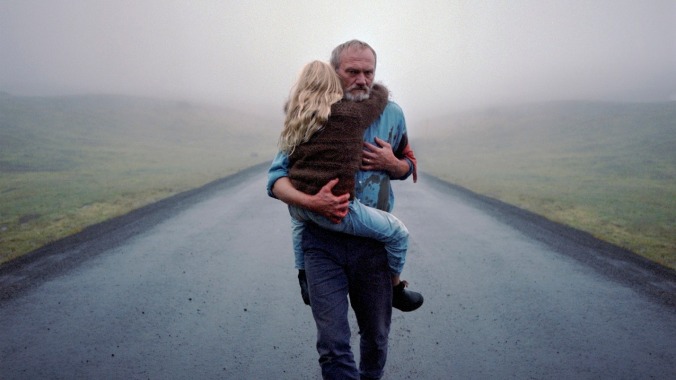The Oscars should have made room for the intense and elemental A White, White Day

Midway through A White, White Day, which was Iceland’s Oscar submission last year (it wasn’t nominated), a man driving along a seaside road runs over a large rock. This doesn’t damage his four-wheel drive vehicle, but he nonetheless pulls over, gets out, and examines the thing—it’s roughly the size of his head. Then he rolls it out of the road and tosses it down a hill. This man is the film’s protagonist, but the camera doesn’t follow him as he presumably resumes his journey. Instead, it follows the rock, which tumbles down and down and down and down, for longer than seems geographically possible. Director Hlynur Pálmason observes its progress over the course of 13 separate shots that last nearly a full minute, which is a long time to watch a big rock do the gravity dance. Eventually, it tumbles over a cliff, splashes into the North Atlantic, and sinks to the ocean floor, there to remain for who knows how long. Millennia, maybe.
What’s striking about A White, White Day is the way that Pálmason (whose debut feature, Winter Brothers, got him some attention on the festival circuit) juxtaposes symbolic abstraction like that with acute psychological detail. The rock doesn’t represent anything in particular, apart from echoing a tragic loss that hangs over the entire movie. It just takes on emotional weight that otherwise remains unexpressed, because those feelings are constantly sublimated into furious activity and pointless anger. Pálmason prepares viewers for this offbeat approach by mostly keeping human beings offscreen for a while, devoting several minutes at the beginning to a fixed-camera shot of an isolated house as seen over the course of months or even years: by day, by night, in heavy rain, shrouded in snow, surrounded by horses, devoid of any life. We don’t have any idea to whom the house belongs—it’s not even clear at first that it’s a residence, as opposed to some sort of industrial building—so the sequence functions exclusively as a portrait of time passing, not for some character in particular but simply as an attribute of existence.
There is a narrative, though, which finally gets underway when middle-aged widower Ingimundur (Ingvar Eggert Sigurdsson) shows up at the house with his pre-teen granddaughter, Salka (Ída Mekkín Hlynsdóttir). He’s turning it into a livable home for Salka and her mother—a labor-intensive project that keeps him from thinking too hard about his late wife, who died in a car accident that’s depicted with eerily impassive remove at the outset. Evidence surfaces that she might have been having an affair at the time of her death; Ingimundur, who was already on the prickly side (as evidenced by his impatience during what seem to be court-mandated therapy sessions), becomes consumed with jealous rage. He starts stalking the man (Hilmur Snær Guðnason) he suspects was her lover, joining a soccer team that competes against his. But his tortured emotions also seep into his relationship with Salka, despite his deep love for her. A White, White Day is a film in which someone digs his own grave at gunpoint. But it’s also the kind of film where that scene is arguably less upsetting than a scary bedtime story that turns uncomfortably sadistic, and less disturbing than a bizarre children’s TV show (watched by Salka) that features an astronaut on a deep-space mission who not only faces certain death but screams at viewers that they, too, will surely die one day.
Back in 1999, Harrison Ford and Kristin Scott Thomas starred in a now-forgotten melodrama, Random Hearts, about a policeman and Congresswoman who meet when their spouses, who’d been having an affair, are killed in a plane crash. It was a bad movie, but it had the germ of an interesting, Atom Egoyan-esque idea: two people so obsessed with having been betrayed by corpses that they become dead to each other, squandering potential happiness. Though entirely unrelated, A White, White Day takes that basic idea (right down to Ingimundur being a cop) and actually runs with it, depicting misdirected grief in hauntingly oblique ways. Sigurdsson’s volcanic performance not only reveals every dark crevice of Ingimundur but deftly suggests the troubled history of a marriage that we never see—in essence, he’s providing the contours of the dead woman’s character, as reflected in his own. But the film’s true power is elemental, rooted in weather conditions that all but erase the distinction between land and sky, and in the inky darkness of a tunnel traversed by one haggard, trudging figure whose weary body intermittently blocks a sliver of light barely visible at its far end.